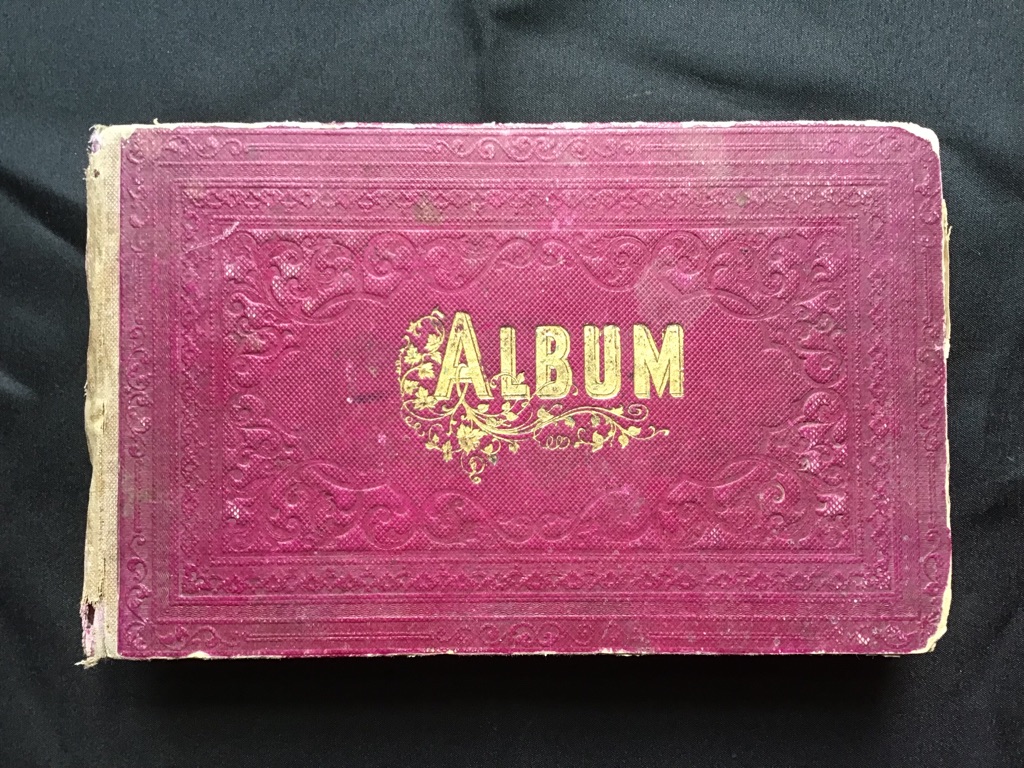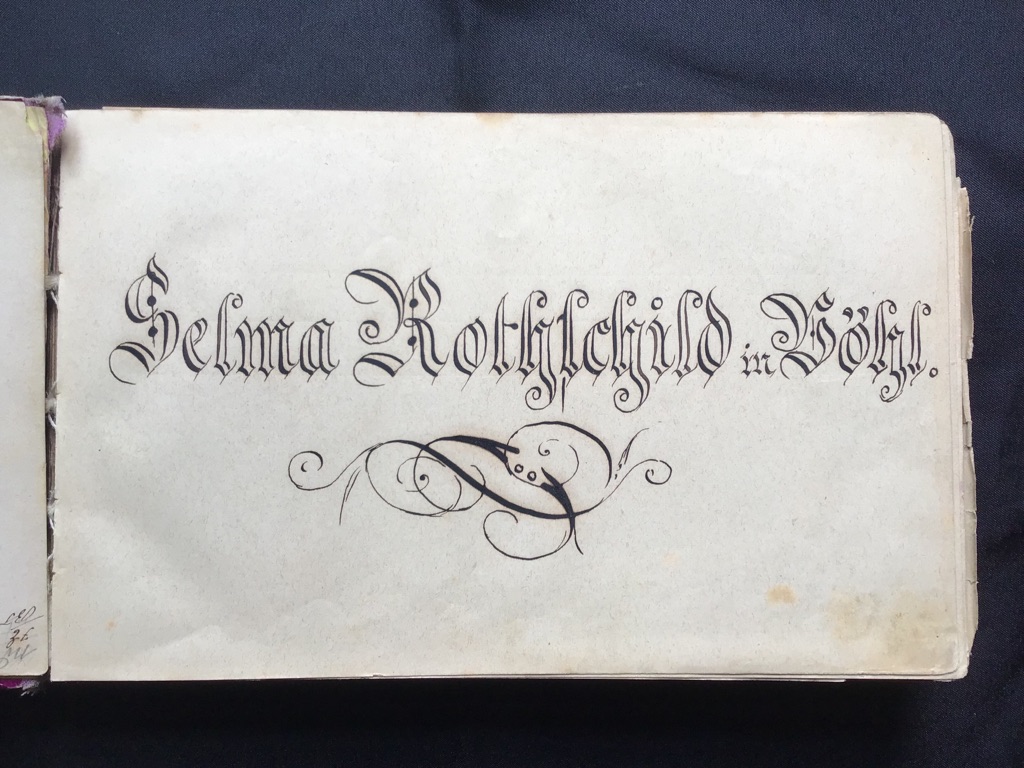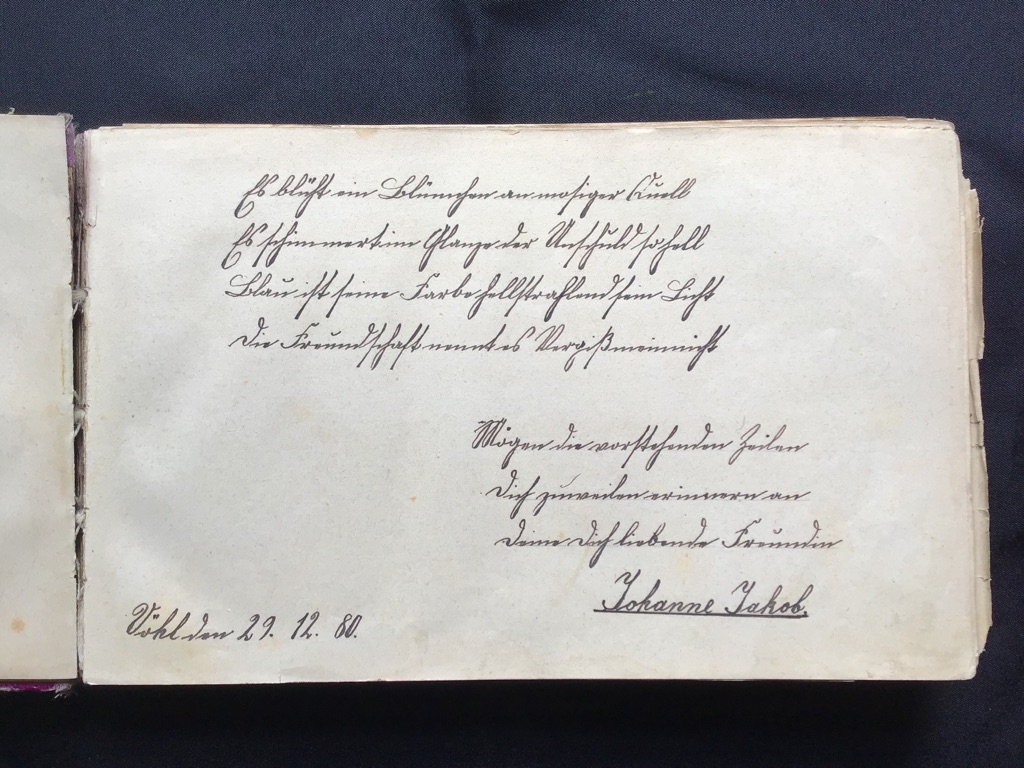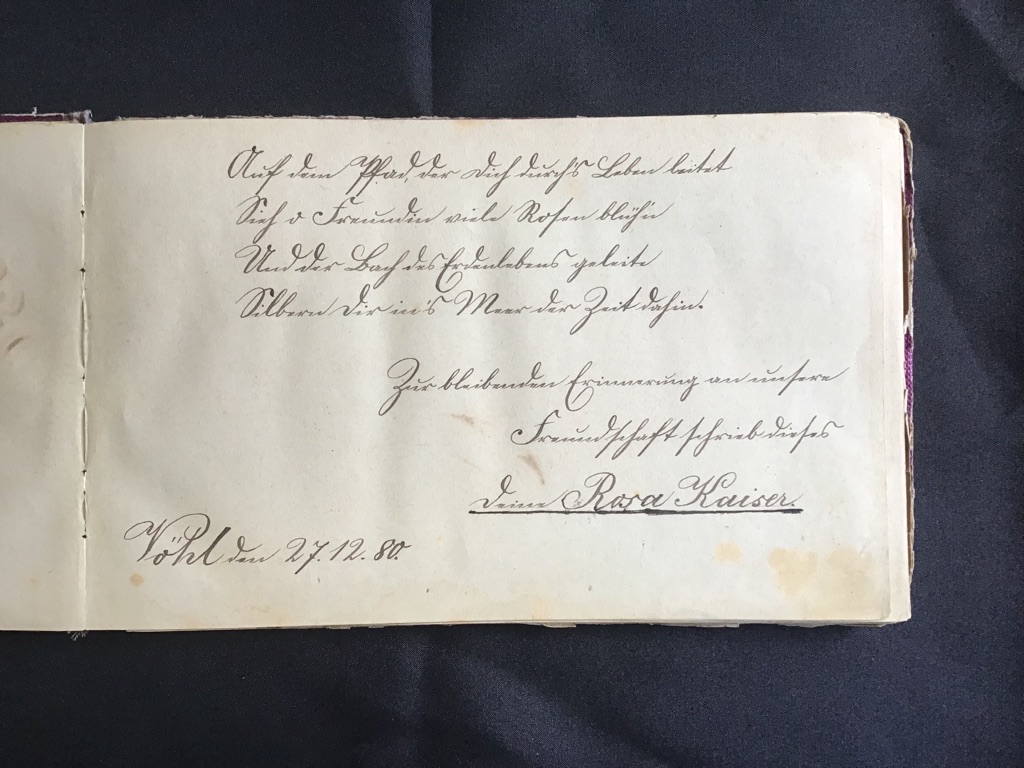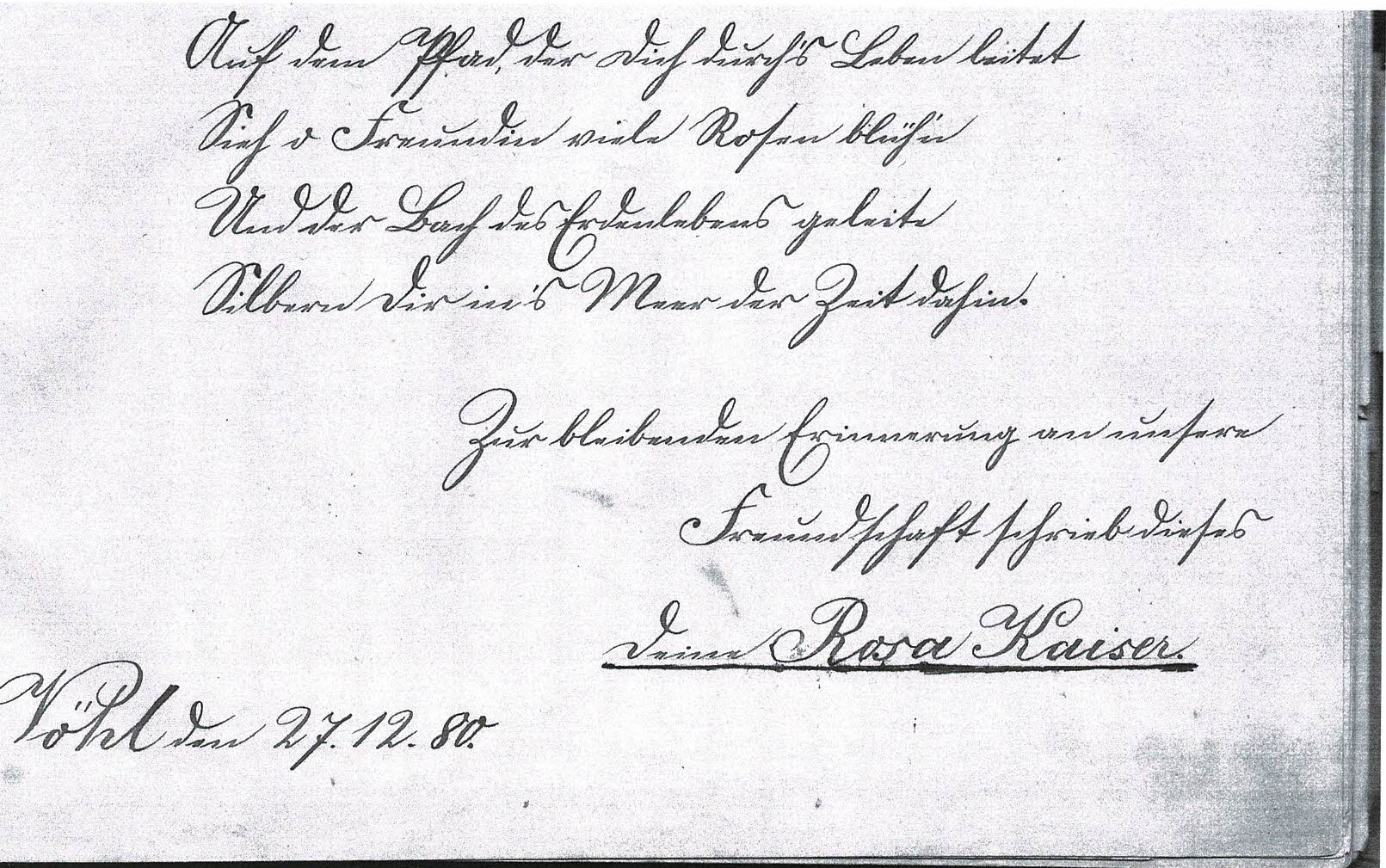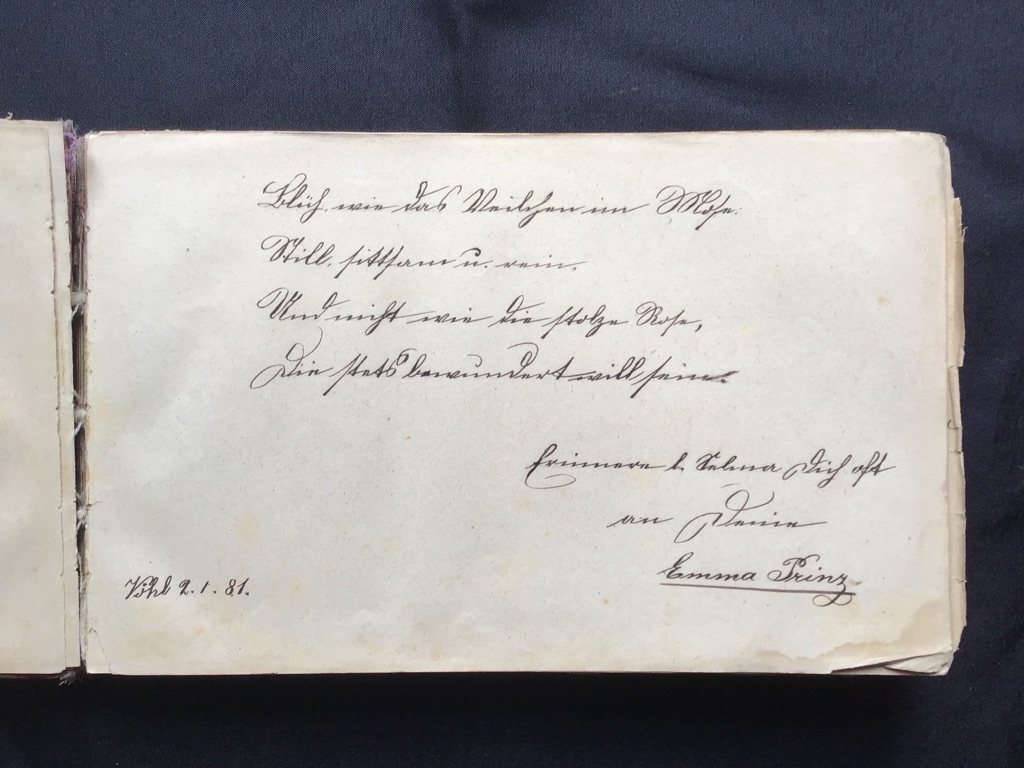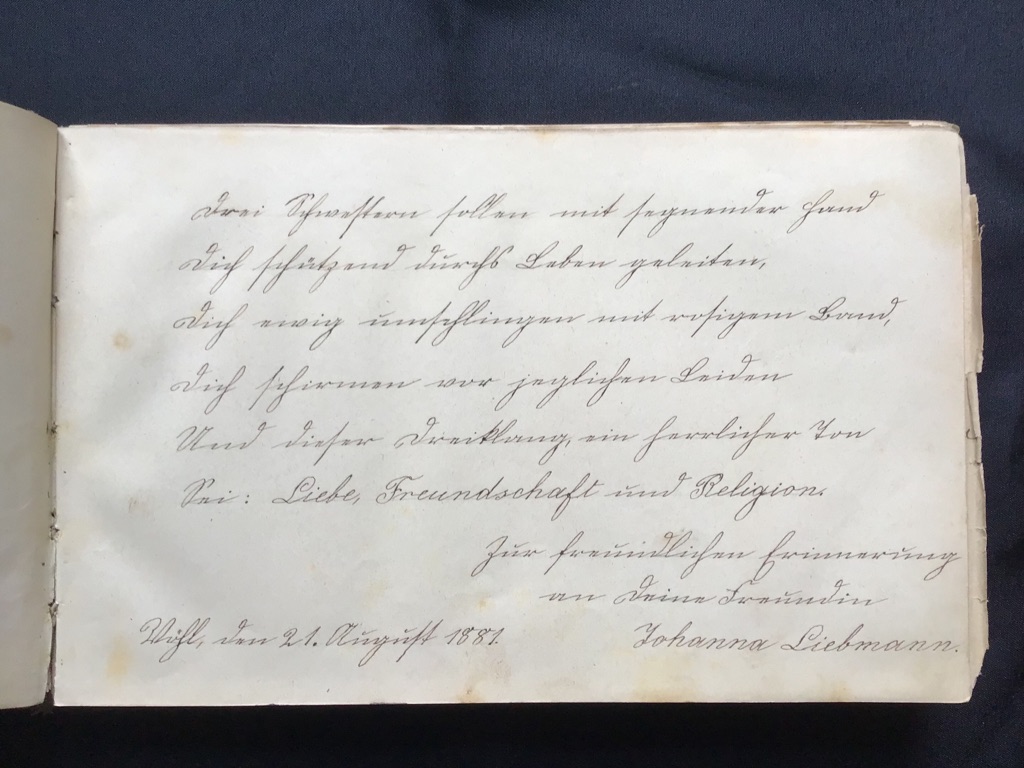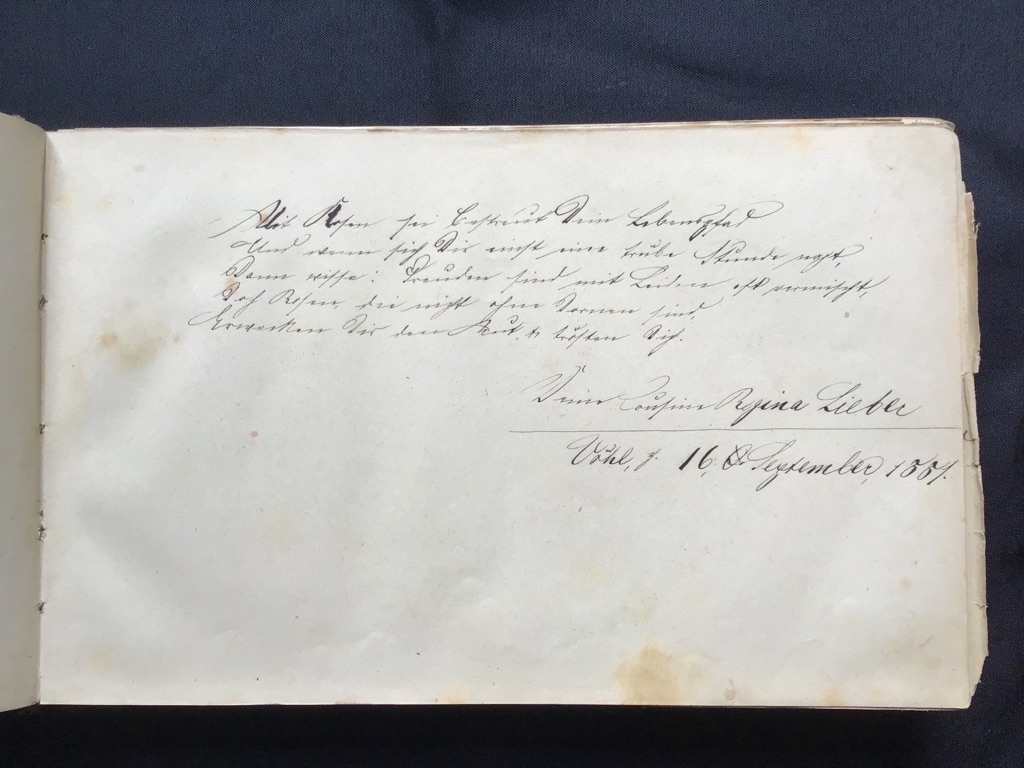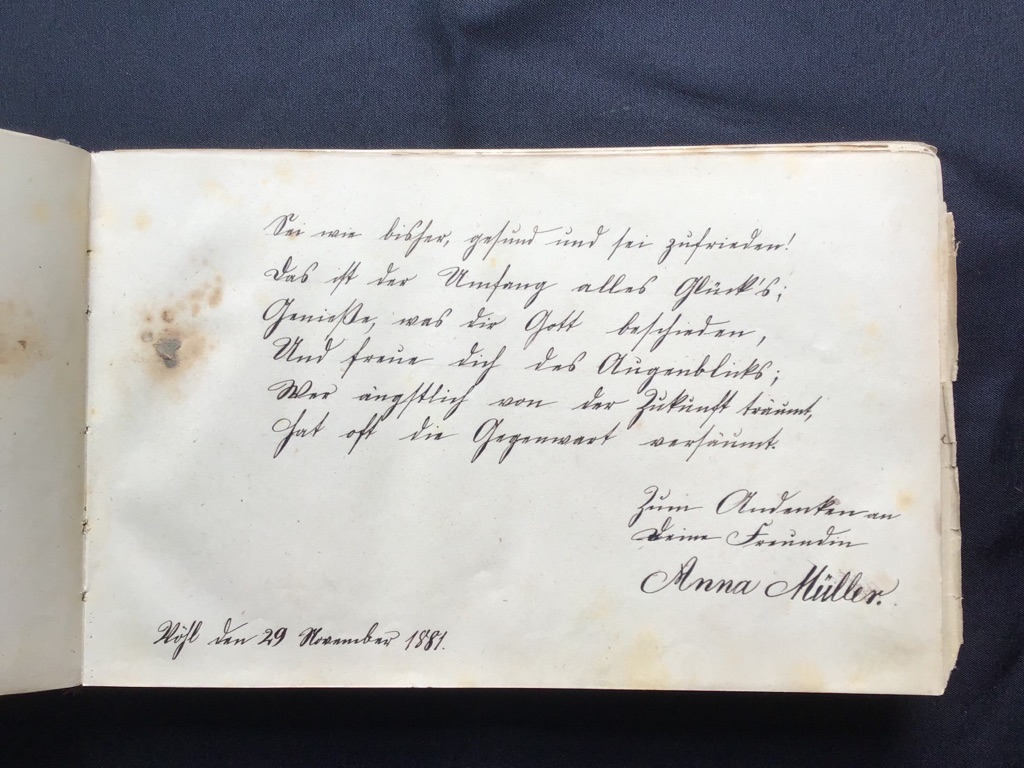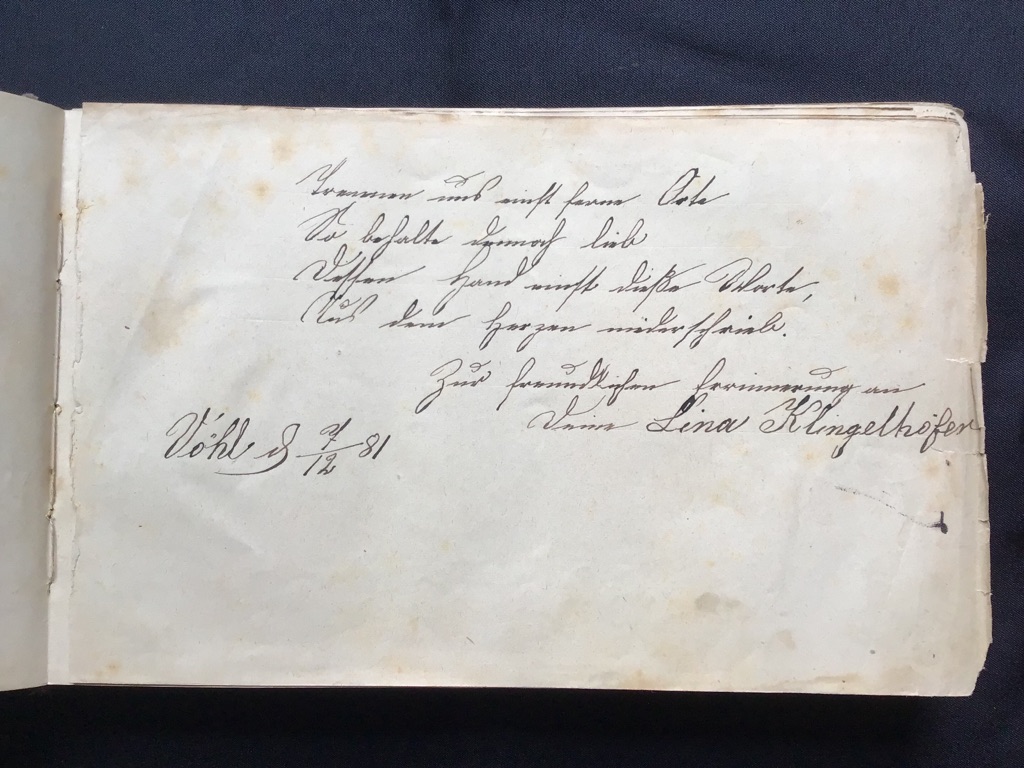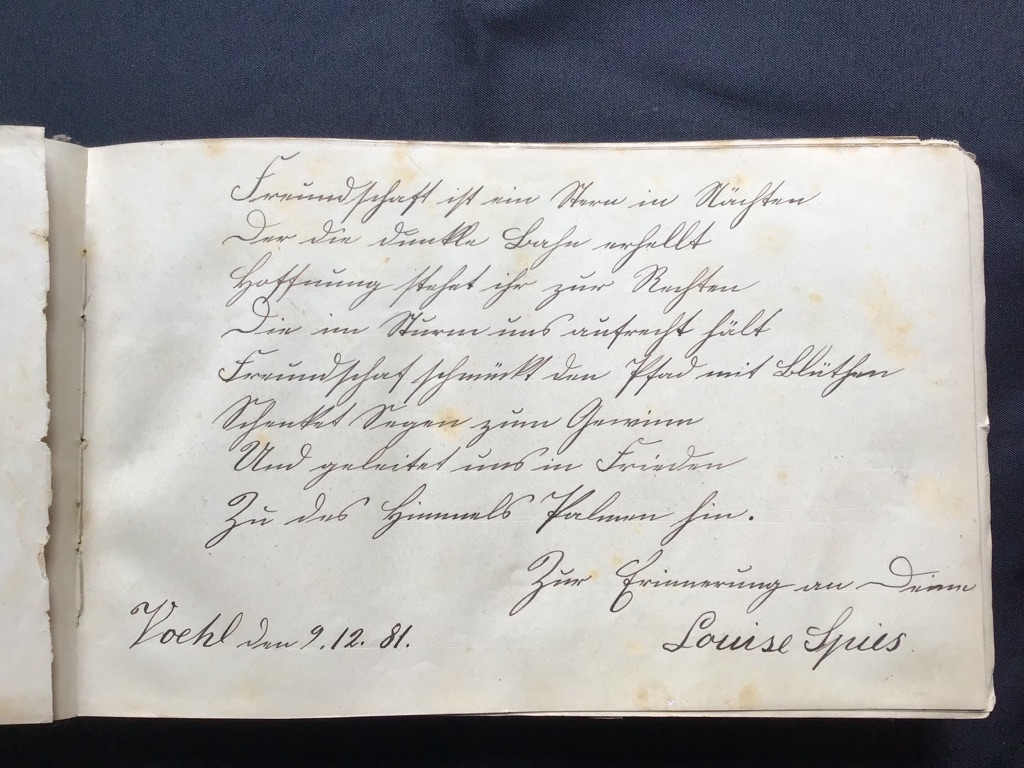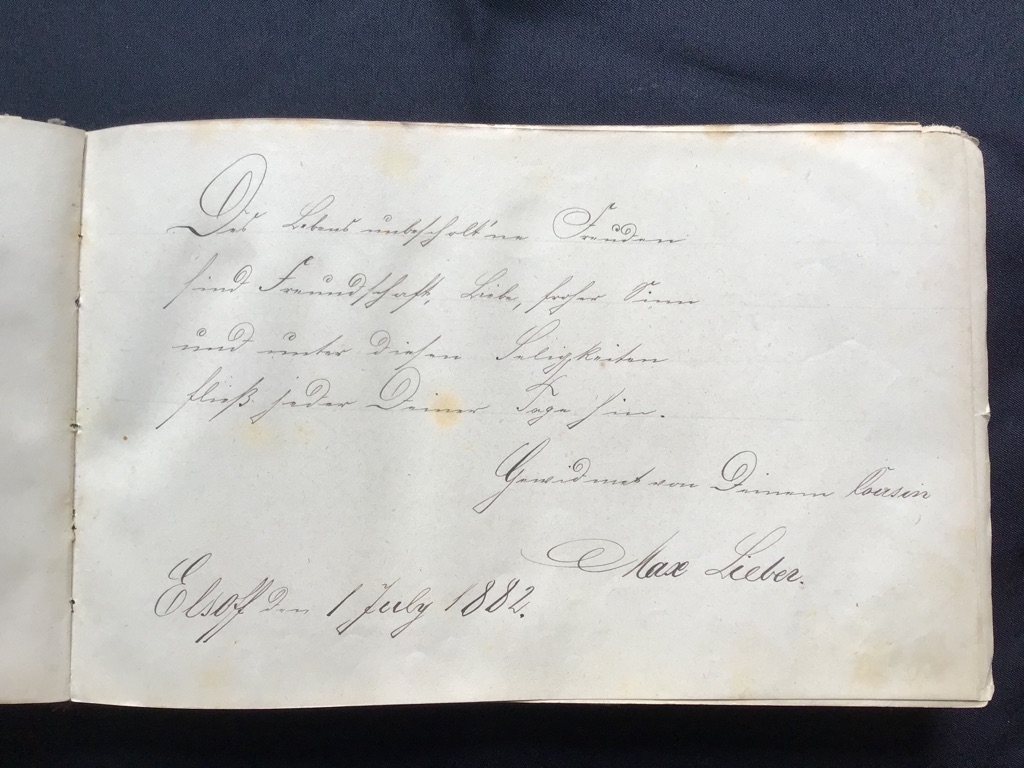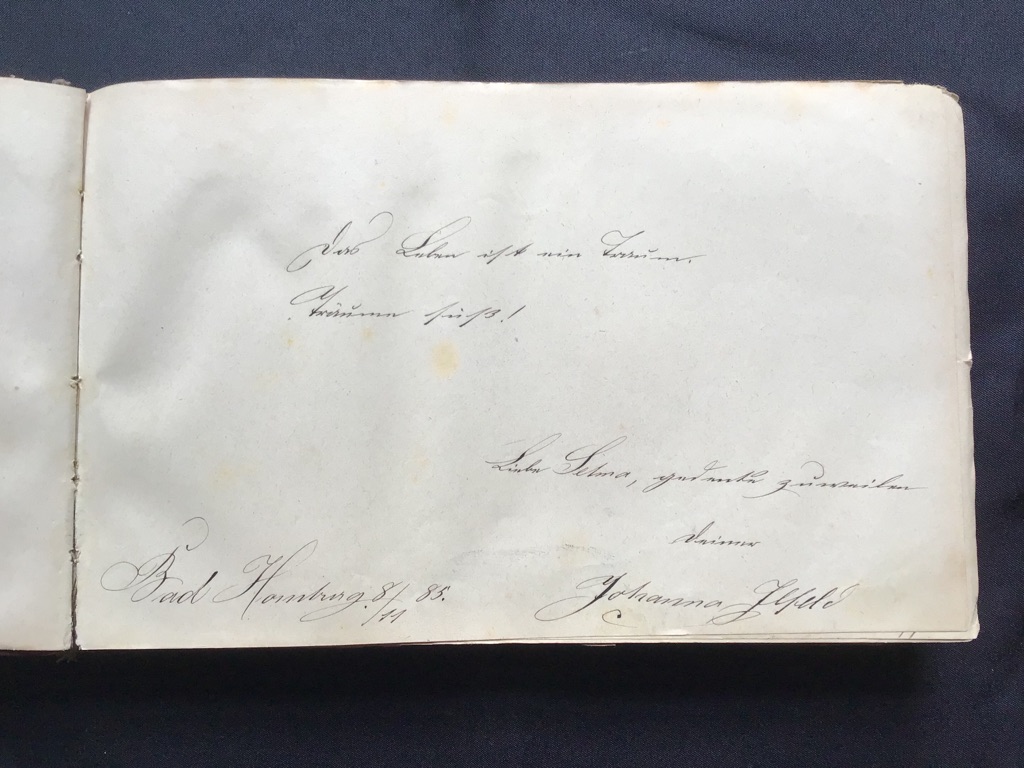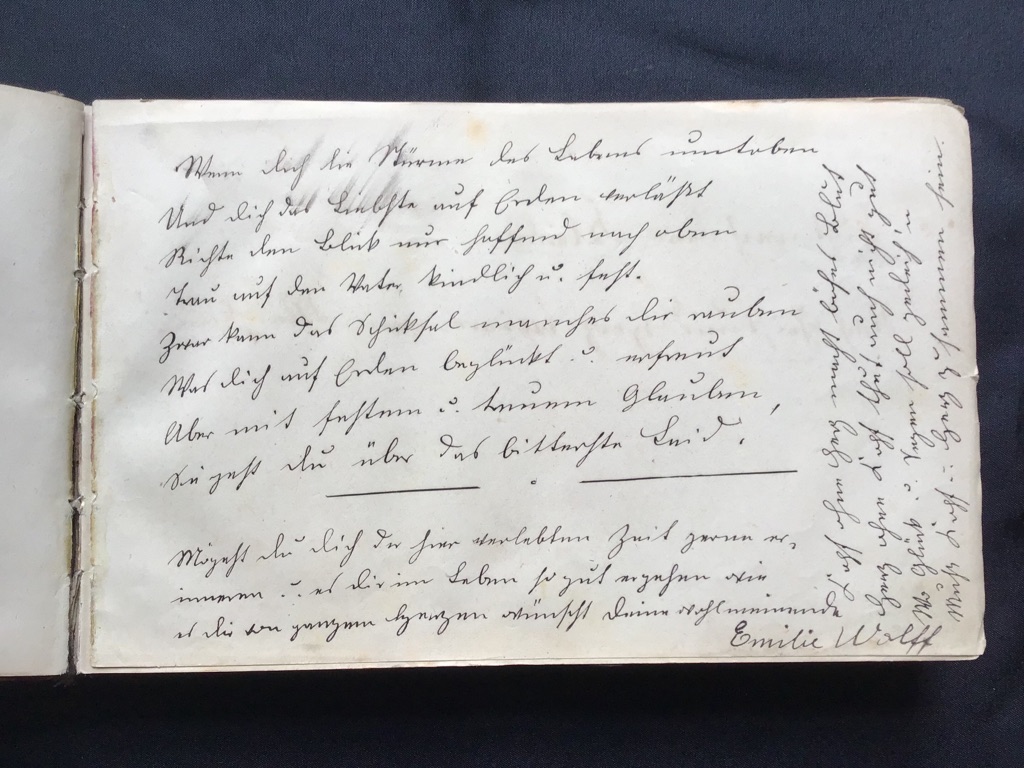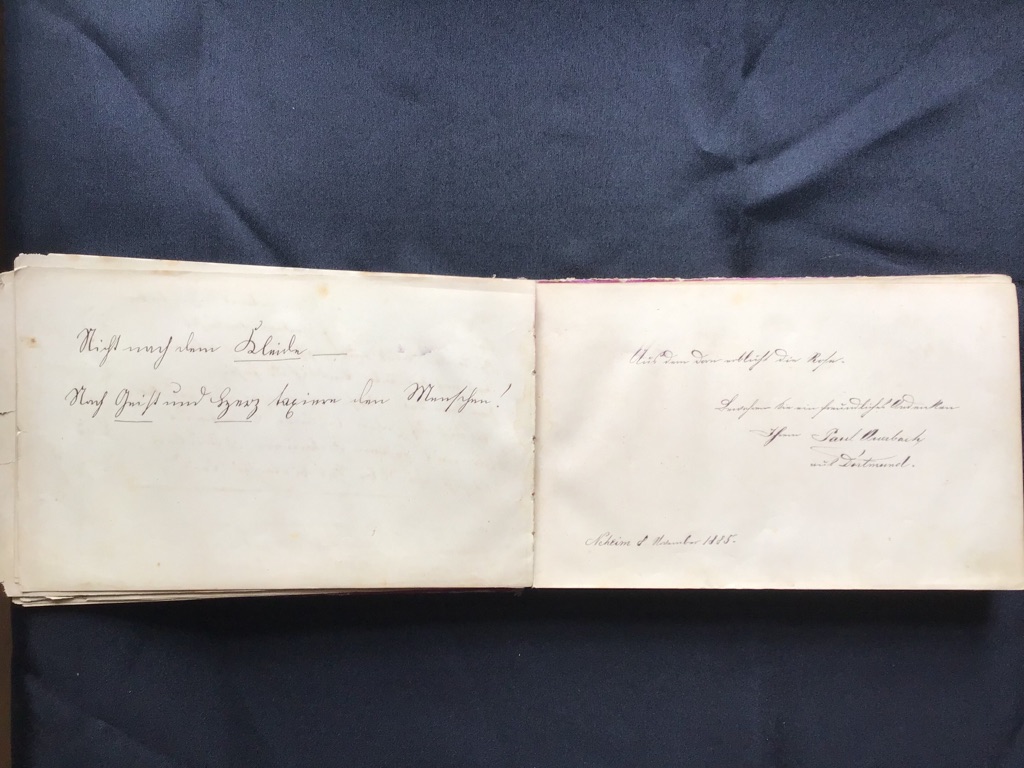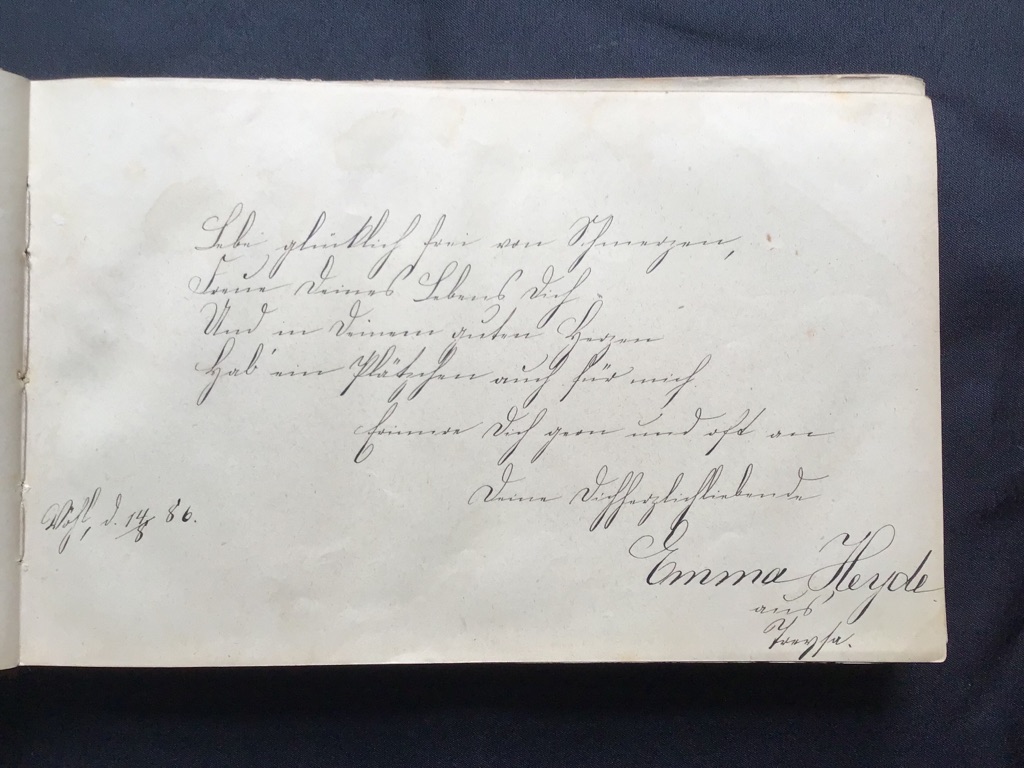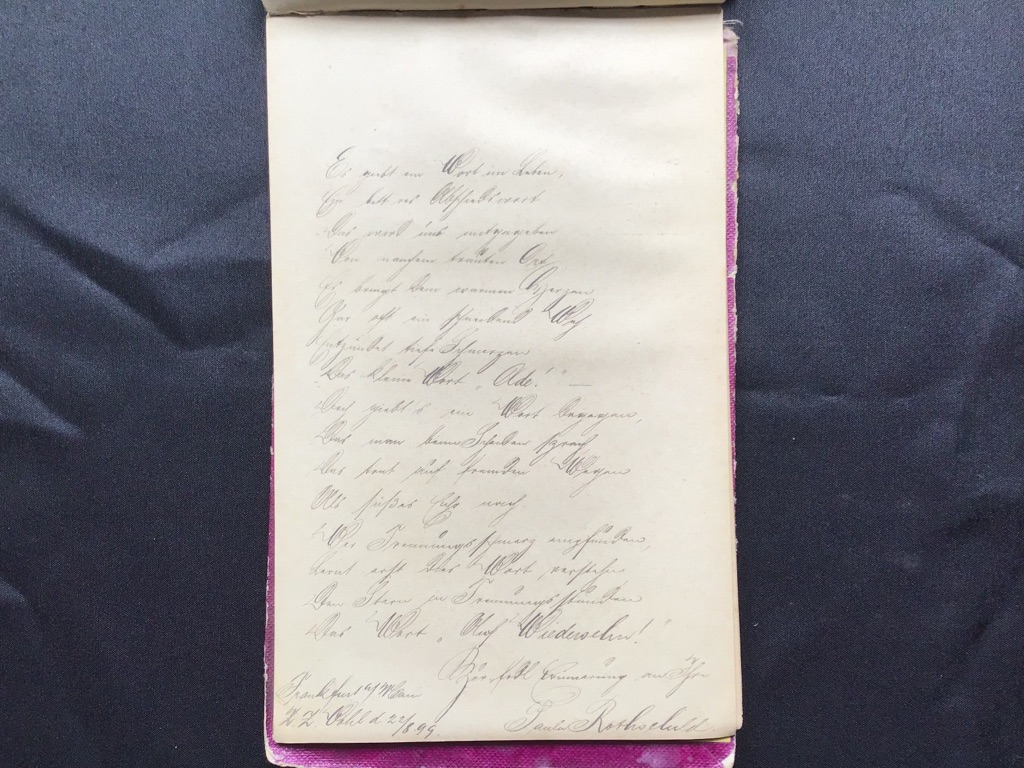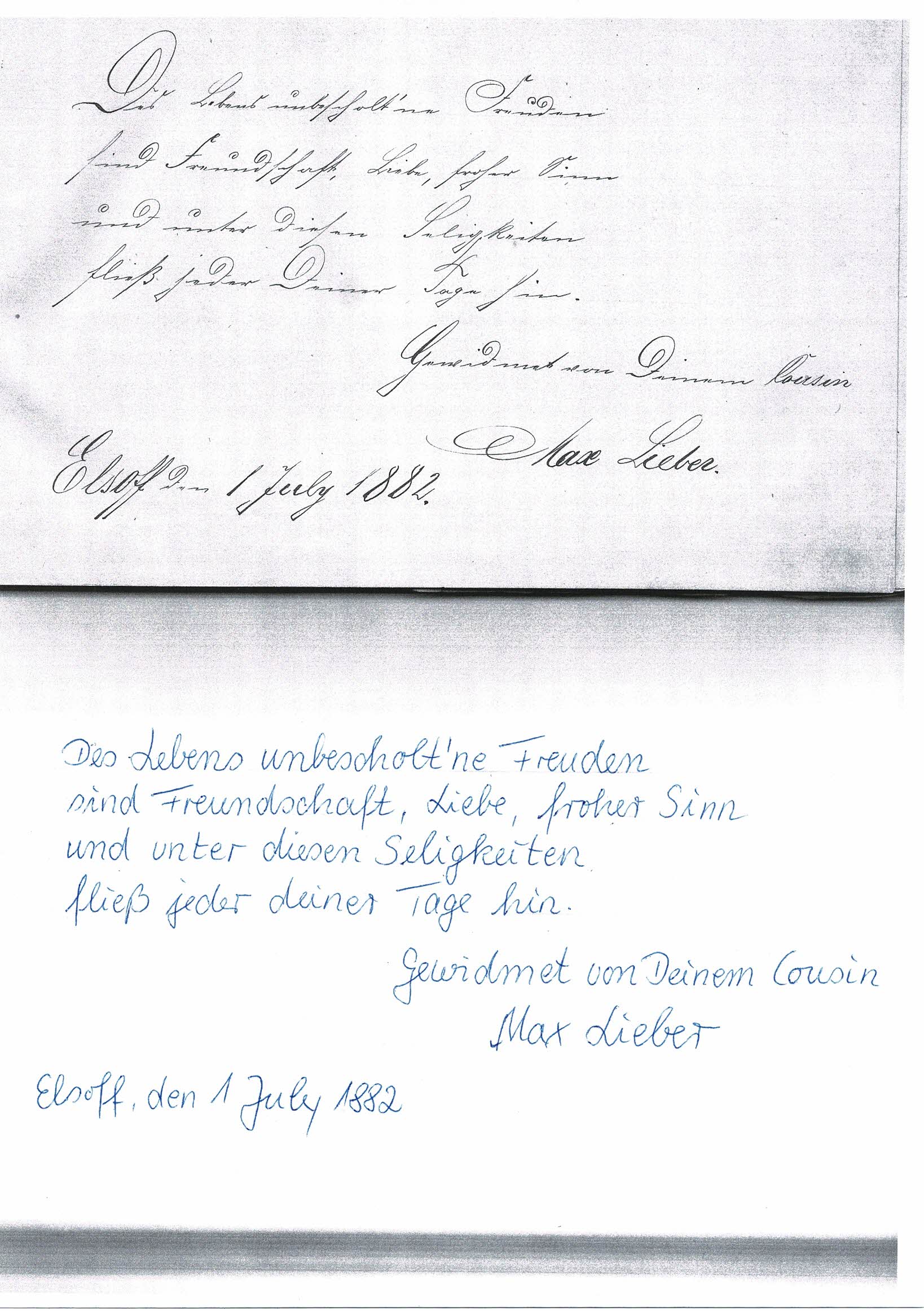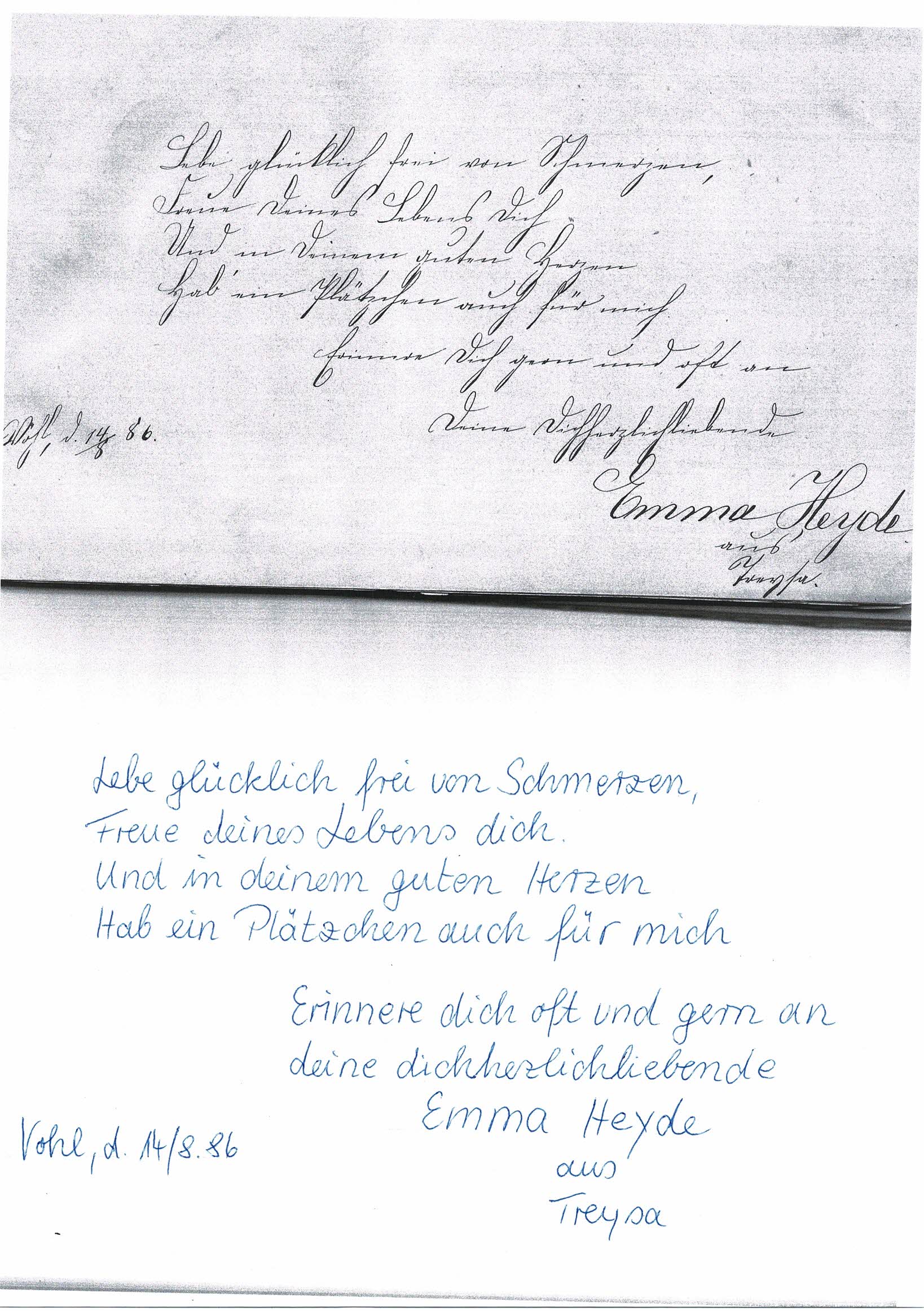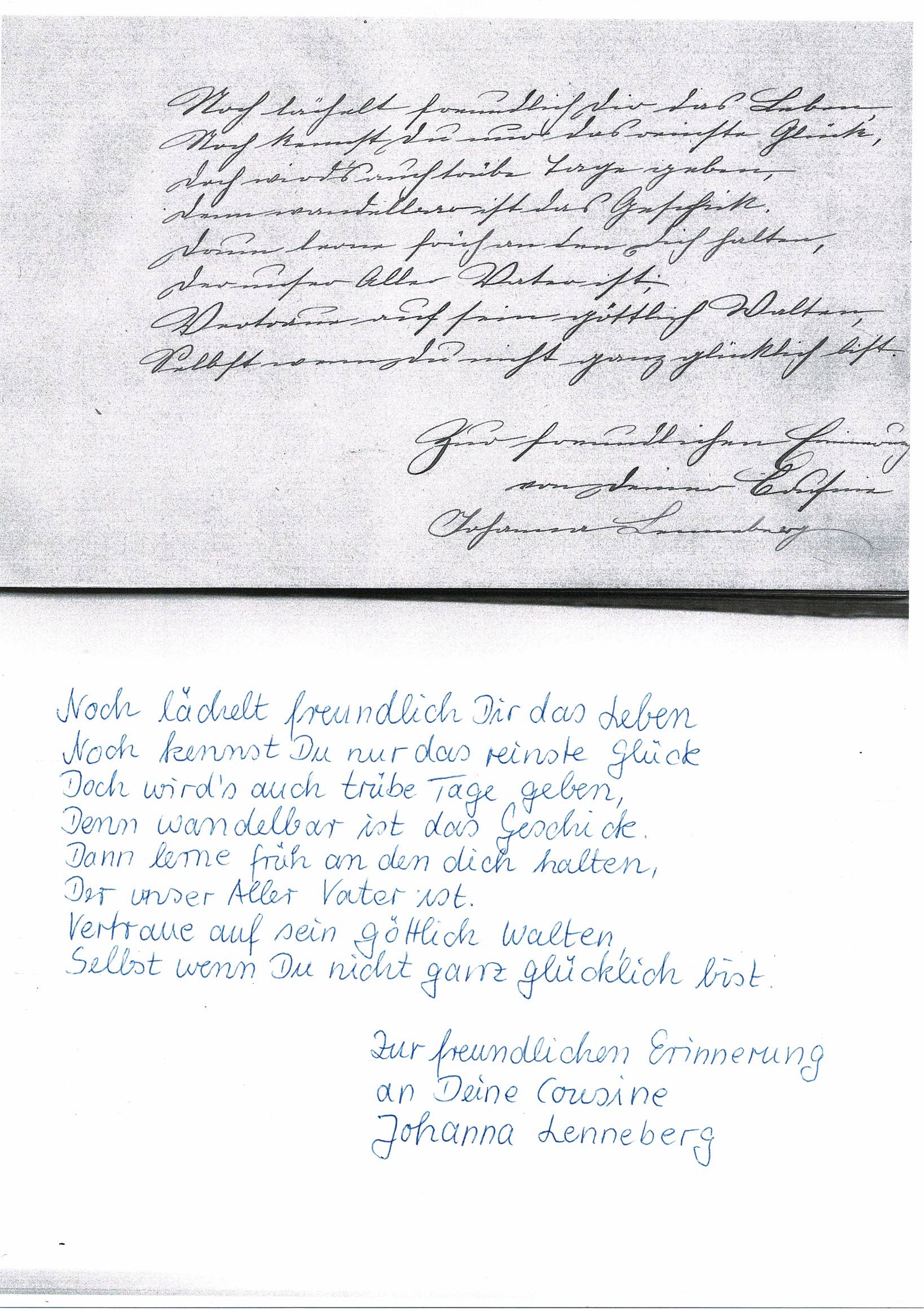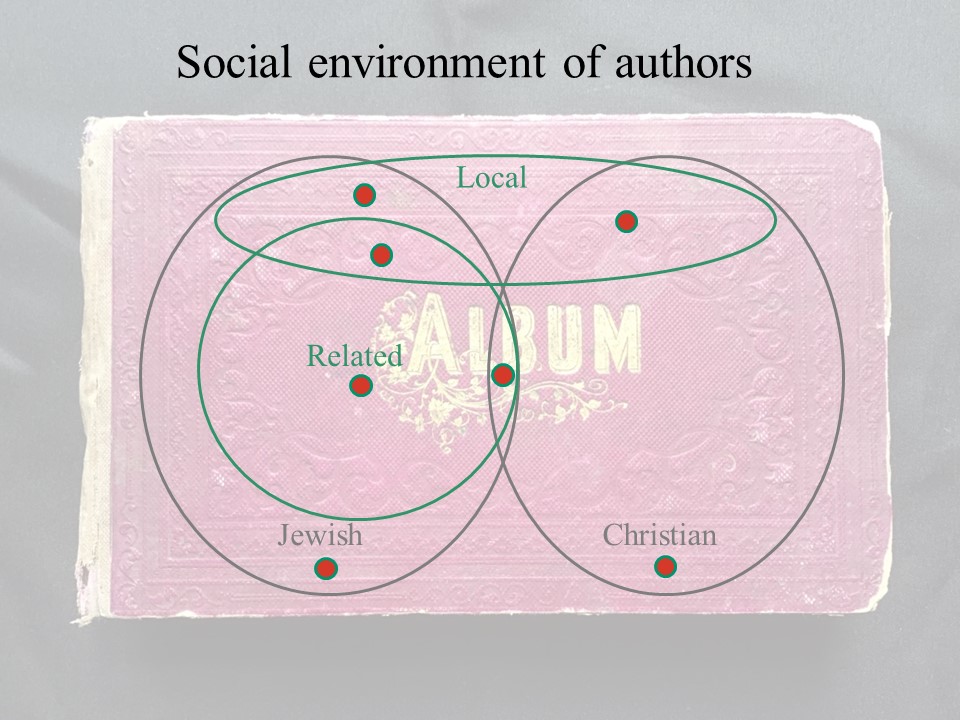

This ‘Passover Book 5706 - 1946’ is already the 2nd edition from 1948, published in Marburg and printed in Giessen. Passover books (Haggadah) tell the story of the Jewish people after the exodus from Egypt. They are sung and read aloud on the eve of Passover. A gift from Dr. Helge-Ulrike Hyams to the Förderverein in 2009. 21.5x15.5x1.3cm
Here is the trancription in current handwriting bei Renate Mahaj.
Research about the authors does create a overview of the people Selma Rothschild met in this period.
Most of the names are linked to more informations.
read more
Georg Ritsdake (sp)
~ ~ ~
As if without fear and impatience,
Some stare at the sky.
Trust in God’s fatherly grace,Built on His wisdom,
That will be the highest earthly good
That dampens all storms.
Oh quiet, firm courage of faith.
Blessed is he who fights for you.
With fond remembrance,
Your
Martha Fritzler
Aachen, the 3rd of September 1885
~ ~ ~
~ ~ ~
~ ~ ~
C. Bayerthal
~ ~ ~
M. Kasper
~ ~ ~
Please press the buttons. Persons are only mentioned once.
The social environment was divided into four groups that form different intersections. The authors are both women and men and are a colourful mix. This may also be due to the fact that S. Rothschild grew up in a family that ran a pub. The largest 3 groups are the Jewish relatives and the Jewish related locals alongside the Jewish locals. In addition to these, there are other smaller groups, such as Jewish authors who do not belong to the 3 groups and Christian authors as locals and non-locals. The group of Christian relatives who also count as Jewish needs to be explained. These are Jews who converted to Christianity and whom the Nazi government continued to treat as Jews.
INDEX – In Order of Entry
Johanne Jakob (Jewish Name?)
Rose Kaiser (Relative, Local, Jewish)
Rohsenstein_Rosa.pdf
Rose Kaiser, aka Rosa Kaiser, was born 22 December 1867 in Vöhl, the daughter of Levi Kaiser and Selka Elias, and gg-granddaughter of Salomon Abraham Rothschild, making her Selma’s 2nd Cousin once removed (2c1x). She married Joseph Rohsenstein, and passed away 30 July 1931[1]. back
Emma Prinz (Local, Christian)
Most likely Emma Florentine Caroline Auguste Bertha Prinz, born 1 August 1866 in Vöhl, daughter of Mathilde and Ferdinand Prinz. In 1893, she married Carl Ludwig Alexander Rudolph Backhaus. They were the parents of at least two children, Karl Hermann Rudolph Ernst Ferdinand Backhaus (20 May 1894 – 14 July 1895), and Rudolph August Hermann Backhaus (2 August 1896 – 25 April 1898)[2]. back
Martha Fritzler
She was living in Aachen at the time she signed Selma’s book. back
Rosalie Stern (Relative, Local, Jewish)
Stern_Rosalie.pdf
Rosalie Stern was born 22 September 1866 in Vöhl, died 1943 in Theresienstadt. Daughter of David Stern and Bertha Buch, gg-granddaughter of Salomon Abraham Rothschild, making her Selma’s 2nd cousin once removed (2c1x). She never married[3]. back
Emma Schönthal (Local, Jewish)
Schönthal_Emma.pdf
Emma Schönthal was born 30 June 1866 to Gütchen Mehler and Emanuel Schönthal. In 1897, she purchased a house and livestock in Schulberg from Christian and Wilhelmine Finke. By 1899, she was living in Offenbach[4]. back
Johanna Liebmann (Local?, Jewish)
Probably a daughter of Hermann Liebmann, oldest son of Salomon Liebmann. Hermann married 1866, and perhaps he had a daughter in the age of Selma; another possibility: the Liebmann family as well as the Bayerthal family lived in Oppenheim; a sister-in-law of Selma’s father Moritz married Heinrich Bayerthal; perhaps Selma met the Liebmann family in Oppenheim.[a] back
Regine Lieber (Relative, Jewish)
A cousin of Selma; Selmas mother Karoline was the daughter of Wolf Lieber and his wife Frommet; Regine was probably the daughter of Karolines brother or sister.[a] back
Anna Müller (Local, Christian)
There are several Families Müller in Vöhl.[a] back
Lina Klingelhöfer (Local, Christian)
Klingelhöfer is the name of a Vöhler family.[a] back
Louise Spies
Helene Liebmann (Local?, Jewish)
Look at “Johanna Liebmann” above. back
Max Lieber (Relative, Jewish)
He lived in Elsoff; look at “Regine Lieber”; probably a son of Karoline’s sister or brother. back
Johanna Ilfeld (Local, Jewish)
There was a family Illfeld (with 3 L) in Altenlotheim.[a] back
Emilie Wolff
Paul Auerbach (Jewish name?)
He lived in Dortmund. back
Max Bergmann
He lived in Hattingen a.d. Ruhr. back
Mathilde Rothschild (Relative, Local, Jewish)
Rothschild_Mathilde1.pdf
Mathilde Rothschild was Selma’s sister, and was born in Vöhl 27 April 1868. She never married, and it is believed she joined the Red Cross. Family lore indicates she was estranged from her parents and siblings, but the reasoning is not known. She died 26 September 1938 in Hamburg, Germany. back
Emma Heyde (Local, Christian)
Emma Maria Sophia Heyde was born 9 September 1871 in Treysa, Hesse, Germany. She was the daughter of Carl Friedrich Heyde and Marie Elisabeth Crede. She married Friedrich Wilhelm Henck, and they were the parents of at least one child, Friedrich Carl Wilhelm Henck. Emma died 14 June 1945 in Treysa, Hesse, Germany[5]. back
C. Bayerthal (Relative, Christian)
This is most likely Karl (or Carl) Heinrich Bayerthal. He was born 5 October 1870 in Oppenheim, Hesse, Germany, son of Heinrich Bayerthal and Mathilde Rothschild, who was the daughter of Ascher Rothschild and Blümchen Sternberg. Karl married Johanna Berhnhards, and they were the parents of Theodor Heinrich Bayerthal and Anna Pauline Bayerthal. Karl died 1 September 1912 in Mainz, Germany[6] back
Alex Bayerthal (Relative, Christian, seen as Jewish)
Bayerthal_Alexander.pdf
Alexander Hugo Oskar Eduard Bayerthal was born 30 December 1867 in Oppenheim, Hesse, Germany, and was Karl’s older brother. He married Anna Luise Claß, and they were the parents of Mathilde Wilhelmine Luise Bayerthal and Ilse Elisabeth Johanna Bayerthal. Though born and raised Lutheran, the Nazi party identified him as a Jew. He died at home on 21 October 1943[7]. back
Hugo Bayerthal (Relative, Christian, seen as Jewish)
Hugo Philipp Bayerthal was born 21 May 1872 in Sprendlingen, Mainz-Bingen, Germany, the son of Heinrich Bayerthal and Mathilde Rothschild. He married Elisabeth Elsa Weiss (1882 – 1944) on 21 July 1905 in Frankfurt. They were the parents of Ernst Ludwig Bayerthal. Though raised Lutheran, the Nazi party identified Hugo as a Jew. He was deported from Darmstadt to Theresienstadt Ghetto on Transport XVII/1 on 27 September 1942[1]. His exact date of death is not known. Hugo was Selma’s 1st cousin.[b] back
Paula Bayerthal (Relative, Christian, seen as Jewish)
Paula Judith Auguste Bayerthal was born in Oppenheim, Hesse, Germany on 4 June 1869, the only daughter of Heinrich Bayerthal and Mathilde Rothschild. She married Oskar August Knublauch on 9 September 1895 in Mainz. Despite being raised as, and identifying as, a Lutheran, the Nazi party identified her as a Jew. She was sent to Theresienstadt, arriving there on 27 September 1942, and was murdered. She and her brother Hugo were on the same transport[1]. Her exact death date is not known. The fate of her husband is also unknown. Paula was Selma’s 1st cousin.[c] back
Julie Müller
In her writing, Julie indicates she’s from Gießen. back
Johanna Lenneberg (Relative, Jewish)
Lenneberg_Adelheid.pdf
Johanna Magdalena Lenneberg was born 7 July 1862 in Mainz, Germany. She was the oldest child of Julius Isaac Lenneberg and Adelheid Rothschild, who was the daughter of Ascher Rothschild and Blümchen Sternberg. The last known record of her is a census showing her with her parents and her younger siblings, Alfred, Klara, and Paul. I do not have the date of this census[8]. back
Emma Homberger (Relative?, Jewish?)
Possibly the daughter of Aaron Adolph Homberger and Therese Kaufmann. Aaron was the younger brother of Selma's aunt, Bettie Homberger, who married Siegmund Rothschild. Emma and Selma were not related to each other, but had mutual cousins in the form of Siegmund and Bettie's children: Sophie and Justus Rothschild. Emma Homberger was born about 1856. The family lived in Mannheim, Baden-Würtemberg, Germany, and her parents formed the business Homberger-Kaufmann, dealers of Spirits and Wine. According to the Mannheim address book of 1930, Emma and her sister Anna were the agents for the business. [d] back
Mathilde Eberwein (Relative, Jewish)
friedericke-rothschild-eberwein
Mathilde Eberwein was born 17 December 1852 in Ulrichstein, Hesse, Germany. She was the daughter of Pastor Ernst August Wilhelm Eberwein and Friedericke Rothschild, Selma’s aunt. She never married, and passed away 19 January 1914 in Darmstadt, Hesse Germany[9]. back
Emma Waas (Christian)
Most likely this Emma Waas was born 14 September 1862 in Reichelsheim, Hesse, Germany, and was the daughter of Wilhelm Christian Waas and Elisabethe Margretha Scheib. She never married, and passed away 20 July 1950 in Reichelsheim, Hesse Germany[10]. back
Minnie Kohlberg
Willy Rothschild (Realtive, Local, Jewish)
Rothschild_Willi.pdf
Willy (or Willi) Rothschild was Selma’s brother. He was born 12 November 1879 in Vöhl. He was married twice. First to Hildegard Dahl. Together, they were the parents of Walter Rothschild. Second to Melita Sandels, and they were the parents of Rudolf Rothschild. About 1933 or later, following Hitler’s invasion of Spain, Willy and his family emigrated to Buenos Aires, Argentina, South America, thereby surviving the Holocaust. Willi Rothschild passed away in Buenos Aires on 1 December 1941[11]. Both sons – Walter and Rudolf – and their wives had been guests of the Förderkreis in September 2000. back
Annie Ganslandt (Christian)
Annie (Aennie) Ganslandt was born in 1884. She and her siblings, Walter and Herbert, were the children of Wilhelm Karl August Ganslandt and Elisabeth Hasse Ganslandt. Annie was named after her mother’s older sister, Aennie Hasse, who was also her father’s first wife. Aennie Hasse died 3 months after her wedding. Annie Ganslandt married Franz Ludwig Viktor Schütze, was the mother of Ursula and Herbert. She later married Ernst Köpchen[12]. back
M. Kasper
Hedwig Blumenthal (Relative ?, Jewish)
Hedwig Blumenthal indicated she is Selma’s cousin. I have not yet been able to confirm this connection. back
Herbert Ganslandt (Christian)
Herbert Ganslandt was born 31 October 1888. He and his siblings, Annie and Walter, were the children of Wilhelm Karl August Ganslandt and Elisabeth Hasse Ganslandt. He married Marianne Faubel in 1926. He passed away 20 December 1949[13]. back
Martha Sangstadt
She lived in Berlin. back
Luise Nelle
Anna Stern (Relative, Local, Jewish)
She lived in Schmallenberg. back
Mrs. Siemon Stern (Relative, Local, Jewish)
Most likely the mother of Mrs. Ida Kaiser, below. back
Mrs. Ida Kaiser (Relative, Local, Jewish)
Kaiser_Ida_1873.pdf
Ferdinand Kaiser of Vöhl married twice. I believe this to be his first wife. Ida Stern was born 2 May 1873 in Schmallenberg, the daughter of Simon Stern and Helene Löwenstern. She married Ferdinand Kaiser, and together they were the parents of Brunhilde Kaiser and Leopold Kaiser. She passed away in Vöhl in 1901[14]. Given that her maiden name was Stern, and that she was from Schmallenberg, I suspect the two women immediately above, Mrs. Simon Stern and Anna Stern, were her relatives. back
Dorchen Buen
She lived in Hungen. back
C. Rosenthal (Jewish Name?)
Lived in Mainz. back
Paula Rothschild (Relative, Local, Jewish)
Schlesinger_Paula.pdf
Paula Rothschild was born 15 June 1868 in Vöhl, the daughter of Selig Rothschild and Emilia Wallach. She and Selma were second cousins once removed. She married Nathan Teichman in October 1890. He passed away sometime before 1911. She then married Julius Schlesinger in August of 1911 in Berlin. Both Julius and Paula were murdered in the Holocaust, he on 10 June 1942 in Sachenhausen, and she on 24 September 1942 in Theresienstadt[15]. back
Clara Rosenthal (Jewish Name?)
She lived in Mainz. Same person like C. Rosenthal? back
Elfriede Biermann (Local, Jewish)
Biermann_Madilde.pdf
Elfriede Biermann is possibly the child of Selma’s second cousin, Madilde Stern, and her husband Max Biermann of Gera[e]. Madilde was born 7 August 1854 in Vöhl, and married Max 1 April 1833.[f] back
Albert Baruch (Local, Jewish)
Baruch_Albert.pdf
Albert married Erna Katzenstein on the same day he signed Selma’s book; 25 August 1901. In 1904, he moved his family to Essen-Steele, Hesse, Germany. According to his son Bernhard’s death record, he was still living there on 23 August 1942[16]. back
Erna Katzenstein Baruch (Local, Jewish)
Baruch_Erna.pdf
She was born 2 March 1882 in Vöhl, the daughter of Samuel Katzenstein and Cäcilie Reichard. She signed Selma’s book on 25 August 1901, which is the day she married Albert Baruch. The lived in Vöhl for a couple of years, then moved to Essen-Steele, Hesse, Germany. They were the parents of two sons: Bernhard and Heinz. Erna died in Auschwitz 23 August 1942, the same day as her oldest son[17]. back
Auguste indicated she was from Kassel. back
Walter Ganslandt (Christian)
Walter Ganslandt was born in 1886. He and his siblings, Annie and Herbert, were the children of Wilhelm Karl August Ganslandt and Elisabeth Hasse Ganslandt. The family spent many years in London, where Herr Ganslandt worked as an internationally active merchant, but returned to live in Kassel in 1898. Elisabeth Ganslandt was a chairwoman of a local milk kitchen and the hospital kitchen, as well as Kassell section chairwoman of the Fatherland Women’s Association, which was mainly active in welfare and nursing, and in the establishment of the Red Cross hospital in Wehlheiden. She was also one of the first six women elected to the Kassel city council in 1919. Walter died 10 October 1914 in an internment camp in Algeria[18]. back
When Selma kept the poetry album, she was probably still living in her parents' house. This was the hotel and inn "Prinz Wilhelm". Some of the people who signed up for the album may have been hotel guests.
[1] https://www.ancestry.com/family-tree/person/tree/34523572/person/160112968342/facts
[2] https://www.ancestry.com/family-tree/person/tree/183628935/person/112397277996/facts
[3] https://yvng.yadvashem.org/nameDetails.html?language=en&itemId=1735725&ind=1
[4] https://www.synagoge-voehl.de/images/pdf/voe/sch/Schnthal_Emma.pdf
[5] https://www.ancestry.com/imageviewer/collections/61119/images/treysa_8095_1945-00199?pId=2326295
[6] https://www.ancestry.com/imageviewer/collections/7434/images/41516_SRMZ1912000002-00460?pId=130120
[7] https://www.ancestry.com/imageviewer/collections/61119/images/frankfurt-v_182_1943-00582?pId=1799113
[8] https://www.ancestry.com/discoveryui-content/view/72153:8958?ssrc=pt&tid=34523572&pid=160113145677
[9] https://www.ancestry.com/imageviewer/collections/61119/images/901_390_darmstadt_1914_00034?pId=1654725
[10] https://www.ancestry.com/discoveryui-content/view/2605984:61119
[11] https://www.synagoge-voehl.de/images/pdf/voe/r/Rothschild_Willi.pdf
[12] https://gw.geneanet.org/henri61?lang=en&pz=auguste&nz=deharveng&p=aennie+marie+emma+maud&n=ganslandt
[13] https://gw.geneanet.org/henri61?lang=en&pz=auguste&nz=deharveng&p=herbert&n=ganslandt&oc=1
[14] https://www.ancestry.com/imageviewer/collections/61119/images/47890_b372786-00011?pId=3792910
[15] https://yvng.yadvashem.org/nameDetails.html?language=en&itemId=11626084&ind=1
[16] https://www.ancestry.com/imageviewer/collections/61119/images/47110_b388738-00130?pId=515159125
[17] https://yvng.yadvashem.org/nameDetails.html?language=en&itemId=4215598&ind=2
[18] https://de.wikipedia.org/wiki/Elisabeth_Ganslandt
[a] Information provided by Karl-Heinz Stadtler.
[b] https://yvng.yadvashem.org/index.html?language=en&s_lastName=Bayerthal&s_firstName=Hugo&s_place=&s_dateOfBirth=
[c] https://yvng.yadvashem.org/nameDetails.html?language=en&itemId=4860235&ind=2
[d] https://www.ancestry.com/discoveryui-content/view/4256117:60778?ssrc=pt&tid=34523572&pid=162408907046
[e] Information provided by Karl-Heinz Stadtler.
[f] https://www.synagoge-voehl.de/images/pdf/voe/b/Biermann_Madilde.pdf

Foto: Karl-Heinz Stadtler, Antiquarisch erworben
A view of the village can be seen, then the ‘Hotel Prinz-Wilhelm - Pension für Sommerfrischler - Telephon im Hause’, as well as ‘Frankfurter Straße’, in which the Gasthof zum Edersee can be seen on the left, the adjoining house, which has now been partially demolished, and then the house owned by Emanuel Katzensein at the time. The ‘Alte Post’ can be seen on the right.

The jar contains a facsimile of a largely preserved scroll.
Between 1947 and 1956, 15 intact scrolls from the period of early Judaism, 3rd century BC to 1st century AD, were found in Qumran (West Bank). Donated by Mrs Schöneweiß from Vöhl-Obernburg. Clay, paper, 16x5cm.

Foto: Noah Sach
Model: German small receiver, DKE 38 (built from 1938 to 1944), Phenoplast, trade name: Bakelite®, wave range: MW and LW, 24cm x 24cm x 12cm, for AC operation, Reich eagle with swastika on the front and on components inside the device, donation from Marburg
The radio is a ‘people's receiver’ from the National Socialist era. It was developed on behalf of Joseph Goebbels, the head of propaganda in the Third Reich, and introduced shortly after Adolf Hitler came to power at the end of January 1933. It was one of the most important pieces of Nazi propaganda. Speeches by Nazi officials were broadcast, false information was spread during the war and the expulsion and thus the murder of the Jews was propagated.
This model comes from Marburg - from a household clearance during the 1980s.

Foto: Karl-Heinz Stadtler
Sabbath lamp on kettle hook, height-adjustable, 8 burning points for the oil flames with drip catcher. Brass, lamp 47x26cm; hook 52 x 9cm (with 10 teeth). On permanent loan from Carol Baird, San Diego, CA
The Sabbath lamp is lit on Friday evening before the start of the Sabbath. The mostly star-shaped hanging lamps with six to eight flames have been typical of Jewish homes since the late Middle Ages. Originally oil lamps, they were later also used as candlesticks and even later some were even converted to electric light. This Shabbat lamp was in the house of the Familie Frankenthal from Vöhl and was given to the Vöhl synagogue on permanent loan by the descendant Carol Baird from the USA.

Fotos: Karl-Heinz Stadtler
Brass, 29.5cm, donated by Mrs Schöneweiß, Vöhl-Obernburg
The Seder evening from 14 Nisan is the eve and prelude to Passover. It is a time to commemorate the Exodus from Egypt with family or the community. The following dishes are served on the Seder plate:
Bitter herbs, e.g. horseradish
Roasted leg of lamb with a little meat
parsley
Charosset - usually a mixture of apples, nuts or almonds, diluted with sweet wine
Salad (lettuce)
Boiled egg

Fotos: Karl-Heinz Stadtler
Donated by the Browa family from Vöhl, horn, 75cm and 60cmm
The shofar or shofar horn, also known as the Halljahr trombone, is an ancient musical instrument from the Middle East. The instrument, made from the horn of a ram or a kudu, has its origins in the Jewish religion and is used for religious purposes. It is the only ancient instrument still in use in synagogues today. The shofar commemorates the planned sacrifice of Isaac by Abraham for God. However, a ram was then sacrificed in Isaac's place, the horns of which were intended to remind God of Israel's vicarious atonement (Genesis chapter 22). Precise instructions regarding the sequence of tones and the manner of blowing are laid down for the morning prayer at the Jewish New Year festival Rosh Ha-Shanah as well as at the end of the Day of Atonement Yom Kippur.
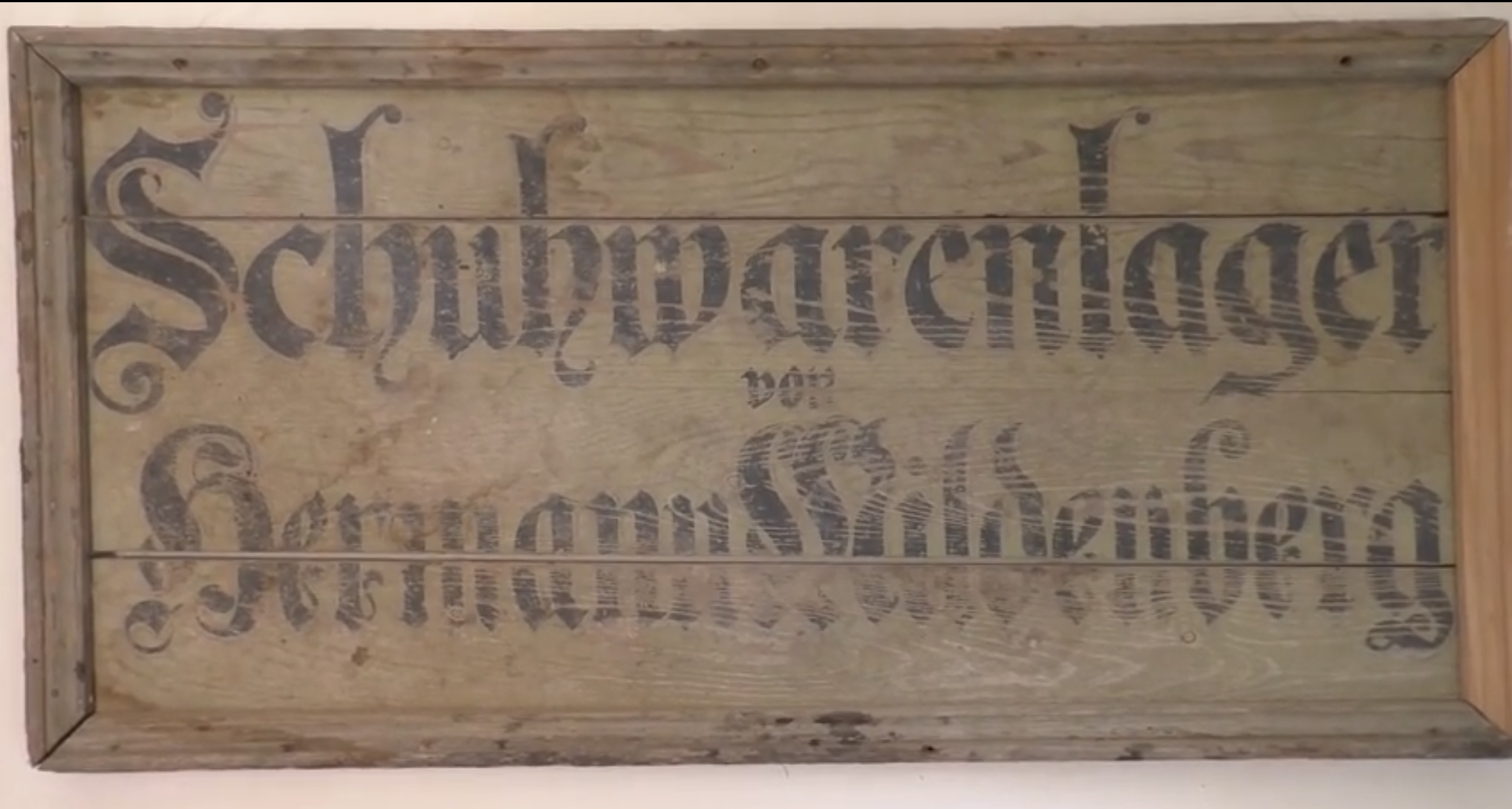
Foto: Karl-Heinz Stadtler
Shop sign of Hermann Mildenberg (1888-1961), who lived in the synagogue flat and was a shoemaker and shoe retailer. He emigrated to the USA in 1937. The sign was in the attic. Softwood, 100x50x4cm.

Siddur 0 front ‘Prayers of the Israelites’, German-Hebrew, translation by Dr Michael Sachs, ‘Sinai’ Publishing, Tel Aviv, Israel,1988, 12x9x2.5cm

Siddur 1 Israel 5060? 1960?, English-Hebrew, ‘Prayer Book of the Israelites’, from Schwalefeld, municipality Willingen, cover metal semi-precious stone, 12,8x9x2,7cm

Siddur 1, endpaper

Siddur 1, title page, text surrounded by the coats of arms of the 12 tribes of Israel.

Siddur 2 front, ‘Prayers of the Israelites’, German-Hebrew, translation by Dr Michael Sachs, ‘Sinai’ Publishing, Tel Aviv, Israel, 1978, cover metal and semi-precious stone, 12.8x9x2.7cm

Siddur 2 back

Siddur 2, endpaper

Siddur 2, title page

Siddur 2, illustration
Fotos: Karl-Heinz Stadtler
The word ‘siddur’ means ‘order’ and refers to the order and sequence of prayers.
A siddur contains the prayers for everyday life and the Sabbath, i.e. the morning, afternoon and evening prayers and the mussaf prayer, which is only said on the Sabbath and on public holidays. In addition, the Siddur contains blessings to be said in the synagogue or at home, prayers for special occasions and the most important prayers for the High Holidays.
All information has been compiled with the kind support of Mr Beni Pollak, teacher at the State Association of Jewish Communities in Hesse.
The publishing house ‘Sinai’ Publishing, Tel Aviv, Israel, is a publishing house from Vienna and Bratislava, founded there in 1853 by Joseph Schlesinger. It moved its headquarters to Tel Aviv in 1939. Beni Pollak is related to the owners of the publishing house.
.
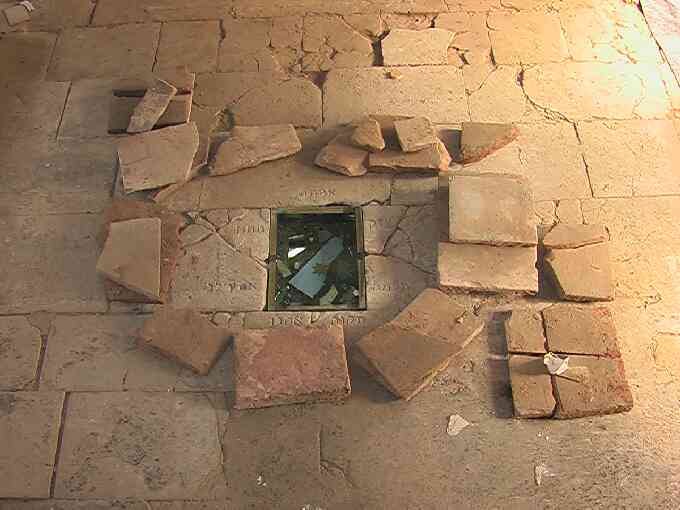
© Kurt-Willi Julius
The artwork ‘morgen - ge-stern (2005) (Stern ohne Himmel auf israelischer Erde)’ by Kurt-Willi Julius is embedded in the old floor tiles.

© Kurt-Willi Julius
Many of the floor slabs were broken and had to be replaced. To make the new slabs recognisable, they are made of different coloured Vosges sandstone. The old slabs had to be removed as the underfloor heating only allowed a certain thickness. More slabs broke in the process.
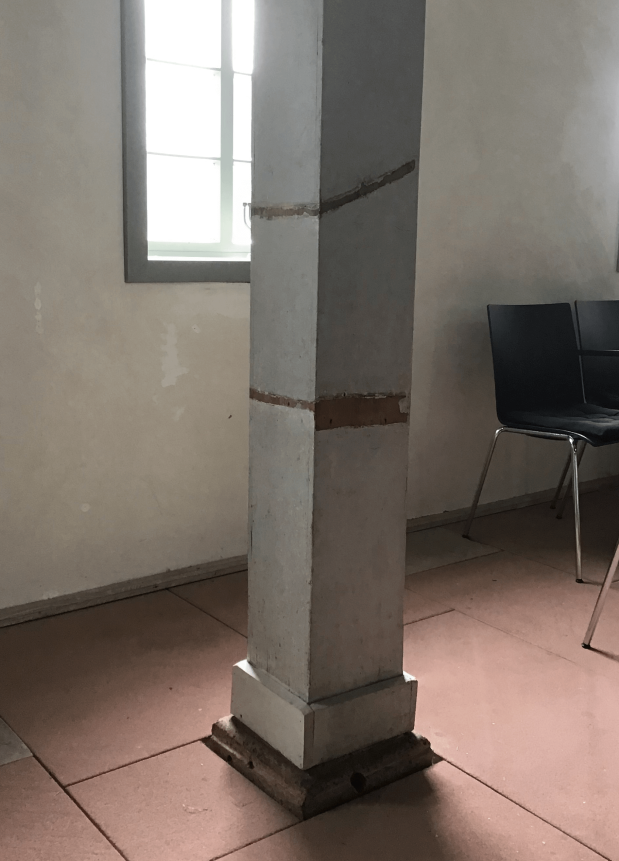
The synagogue benches have been destroyed. Their height and shape can be deduced from the findings in the paintwork on a gallery pillar.

Foto: Noah Sach
This is Hannelore Dreyfuß's burial gown from Battenberg, which she donated to the Förderkreis during her visit in 2009. Tachrichim are traditional simple white burial gowns, usually made of pure linen, in which the bodies of deceased Jews are wrapped.

Foto: Karl-Heinz Stadtler
The prayer shawl (Tallit) is a shawl made of twilled white silk with fringes and scarf threads; one wide and five narrow dark blue stripes are woven into the narrow sides; the head part (the centre part of the upper edge) is edged with a wide silk brocade ribbon. 175x100cm, textile with embroidery with silver thread.

„The Holy Scriptures“ english-hebrew, „Sinai“ Pubishing, Tel Aviv, Israel, 1969, 14,3x11x7cm, binding metal, semi-precious stone.

Title page and endpaper (2nd leaf not visible)
Fotos: Karl-Heinz Stadtler
It is the authoritative form of the modern Hebrew Bible used in rabbinical Judaism. Its content is the Masoretic Text (7th to 10th century AD), which consists of 24 books divided into pesuqim (verses). The Hebrew Bible developed during the Second Temple period, when the Jews decided which religious texts were of divine origin.
The publishing house ‘Sinai’ Publishing, Tel Aviv, Israel, is a publishing house from Vienna and Bratislava, founded there in 1853 by Joseph Schlesinger. It moved its headquarters to Tel Aviv in 1939.

Foto: Karl-Heinz Stadtler
The tefillin (perhaps from the Hebrew tefillah = prayer, i.e. ‘prayer straps’) are straps to which leather capsules or cases are attached, containing four Torah portions written on parchment: Deut. 6, 4-9; ibid. 11, 13-21; Ex. 13, 1-10; ibid. 11-16. They are placed on the hand and head during the morning prayer, on the left arm, opposite the heart, and at forehead level. The texts, which deal with the demand for unlimited love for the one God, responsibility before the eternal judge and the constant grateful remembrance of Israel's liberation from Egyptian bondage, are intended to lead to faithful obedience to God's prayer.
Plastic, 7x5x5cm. Donated by Mrs Schöneweiß from Vöhl-Obernburg.
.
 David Shankbone creator QS:P170,Q12899557, Tefillin worn by a man at the Western Wall in Jerusalem, CC BY 3.0 |
 Yonkeltron at English Wikipedia, Tefillin-shel-yad, CC BY 3.0 |

Foto: Karl-Heinz Stadtler
Contemporary figure of unknown origin, textile, plastic, 20x6x6cm

This Torah curtain comes from New York and was donated to the Förderverein in 2000 by the Mildenberg and Behrend families. The velvet fabric is embroidered with golden thread with golden fringes and borders and measures 220x160cm.
One of two surviving wall lights can be seen on the left. They were used to light the Torah shrine. 
The inscription in the banner reads:
The word ‘she’ refers to wisdom or the Torah.
Fotos: Karl-Heinz Stadtler
The inscription in the donor's signature reads:
"A donation from Meir, son of Samuel Weinberg and his wife
in honour of the lady Eidel, the daughter of
Joel Kofer (or: Kaufer)
May she live a long life.
On the occasion of her reaching the age of 80"
The persons named are members of a Jewish community in New York.
Due to the merging of two Jewish communities, a Torah curtain was no longer used.

Foto: Karl-Heinz Stadtler
33x10cm, wood, paper, textile. Donated by Mrs Schöneweiß from Vöhl-Obernburg.


Fotos: Karl-Heinz Stadtler
This Torah scroll is not complete. For a time, it was kept in a Christian institution in Jerusalem. An accompanying letter states that a German soldier rescued the scroll from the burning synagogue in Vitebsk (Belarus) and brought it to Germany.
Wood, parchment, 65x8.5cm. Donated by Mrs Schöneweiß from Vöhl-Obernburg.

Foto: Karl-Heinz Stadtler
The Torah is a handwritten parchment scroll - sometimes also made of goatskin - containing the Hebrew text of the five books of Moses. A Torah scroll is read from in Jewish services, with the passage for that week being read each week.
A Torah scroll for use in religious services is always written by hand. It is part of the basic equipment of every synagogue.
The scroll is rolled up on two sticks; the ends are held together from time to time by the so-called pennant, made from a circumcision nappy. It is wrapped in an elaborately embroidered cloak and crowned with a crown.
The scroll on display here is not complete. It begins with the 2nd Book of Moses, chapter 9, verse 13, and the parchment is still 9 metres long.
It comes from an antiquarian bookshop in Wroclaw (Breslau), Poland. Wood, parchment, 95x15cm each side
It was donated to the Förderkreis by a Marburg museum that no longer exists. It was handed over by Dr Helge-Ulrike Hyams.
.



